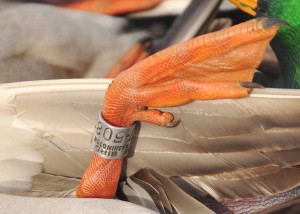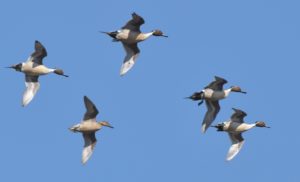Photography courtesy of Lowell Washburn, all rights reserved.
It’s rumored that when throwing important dinner parties, some of our local high rollers like to impress their guests by having live lobsters flown in from Maine or gallons of jumbo shrimp delivered fresh from the Gulf. And although I’m not likely to receive an engraved invitation to any of those social events any time soon, I have no reason to feel jealous. Two can play that game. To prove the point, I’m having tonight’s entrée flown in from Manitoba, Canada.
No, it’s not that I’m all that wealthy. I’m not. Fact of the matter is that the entrée is actually a wheat fattened mallard duck; and the air freight was prepaid by the duck itself. The reason I know the meal originated in Manitoba is because the band on its leg said so.
Bagging a banded bird is always an exciting outdoor event. So much so, that the legs are the very first thing a hopeful hunter checks whenever picking up a downed duck, goose, or dove. I can still vividly recall my first ever banded bird; a drake blue-winged teal taken in 1964on a Winnebago River backwater located north of Ventura on the Duane Lovik farm. The event was made even more memorable by the fact that the banded duck only had one leg. An old healed over wound showed where the other leg had been taken off at the knee – possibly the result of an early encounter with a hungry snapping turtle or who knows what. As it turned out, the bird had been banded just a few weeks earlier at Iowa’s Elk Creek Wildlife Area just a few miles away. It was nevertheless an exciting moment for a young duck hunter. In the decades that followed, I’ve recovered birds banded from a wide variety of locations north, south, east and west. Some birds have been local while other band recoveries have documented amazing long distance travels. The oldest banded bird I’ve recovered, so far, was a Canada goose hatched 13 years earlier in subarctic Canada.
My Manitoba mallard was banded and released in the Minnedosa Pothole Region, an area famed for its abundance of prairie marshlands and stellar production of waterfowl. Although the Minnedosa Potholes sit more than 700 miles to the north, the mallard’s journey seems nothing when compared to the epic flight of a banded pintail bagged earlier this season by Eric Heidman while hunting from a public blind at California’s Delevan National Wildlife Refuge. The duck had been banded fourteen years earlier by the Division of Avian Conservation at the Saitama Duck Refuge located near Obayashi, Japan – a straight line distance of 5,000 miles from where Heidman collected his bird.



 Tom Cope
Tom Cope Sue Wilkinson
Sue Wilkinson Susan Judkins Josten
Susan Judkins Josten Rudi Roeslein
Rudi Roeslein Elyssa McFarland
Elyssa McFarland Mark Langgin
Mark Langgin Adam Janke
Adam Janke Joe Henry
Joe Henry Kristin Ashenbrenner
Kristin Ashenbrenner Joe Wilkinson
Joe Wilkinson Dr. Tammy Mildenstein
Dr. Tammy Mildenstein Sean McMahon
Sean McMahon